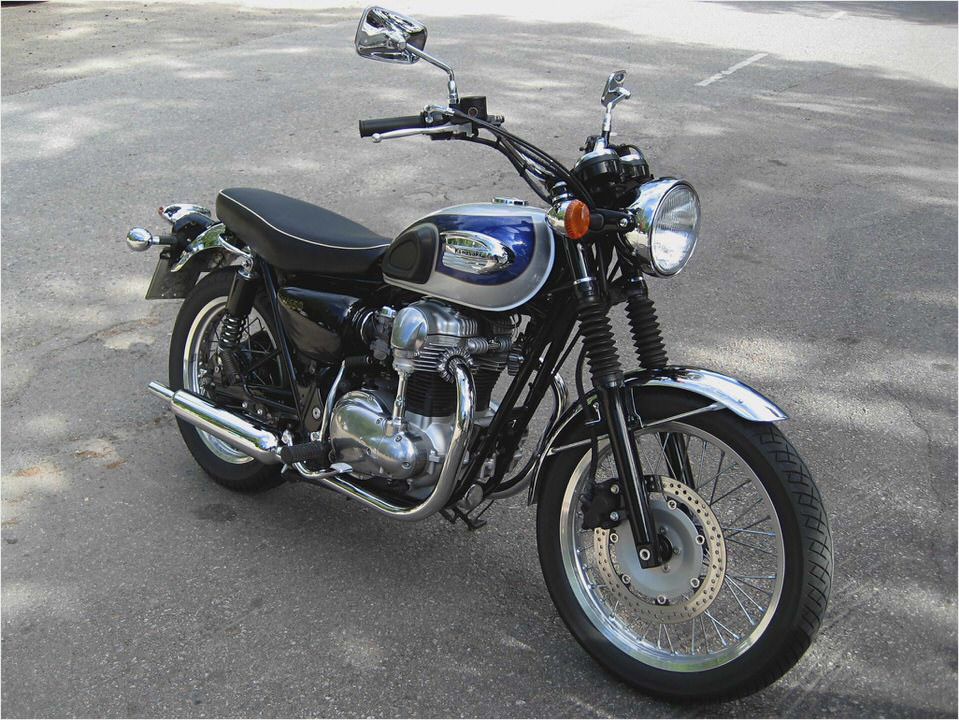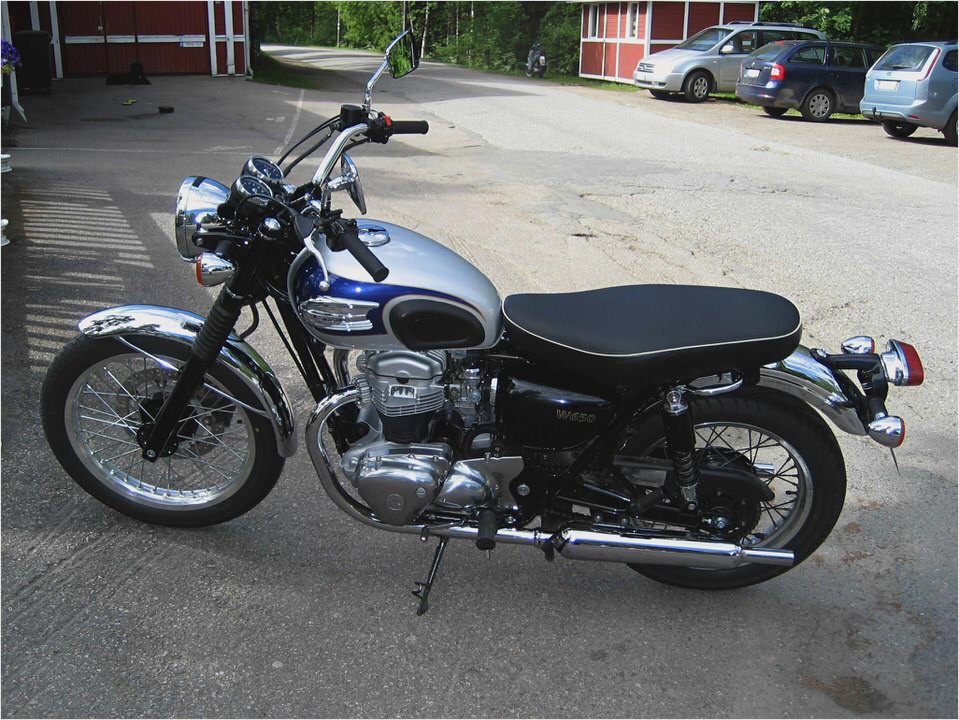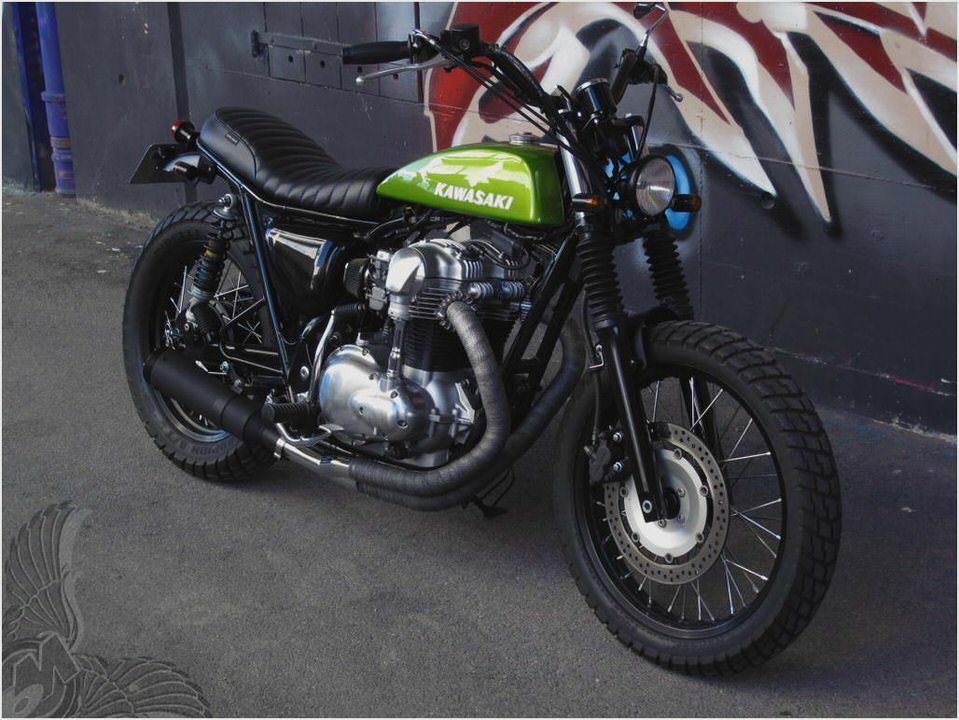
2012 Kawasaki Ninja 650
2012 Kawasaki Ninja 650
– 2012 Kawasaki Ninja 650
2012 Kawasaki Ninja 650 Review
All-new Chassis, Bodywork and Improved Power Delivery Make the Best Mid-sized Sportbike Even Better
They-re known as -sweet spot- motorcycles: streetbikes so balanced, user-friendly and all-around capable that they stand well above their two-wheeled counterparts, forging lasting reputations as exciting, practical and stylish machines.
There aren-t many such overachievers in today-s narrowly focused two-wheeled world. Since its debut back in 2006, the multi-talented Ninja® 650R has been a bona fide member of this elite group, winning accolades from owners and media alike. But for 2012, the massively reworked Ninja 650 is better than ever.
This practical sportbike features a raft of new technology and design elements, including a totally new perimeter-style frame, revised suspension, more angular bodywork, new instrumentation, improved engine performance, a more comfortable saddle, lower seat height and much more. The new-and-massively-improved version promises even more of the all-around capability that suits beginners and veterans alike.
It all starts in the engine bay, where an advanced, highly compact, liquid-cooled 649cc vertical twin works its magic with help from a digital fuel injection system featuring 38mm throttle bodies and sub-throttle assemblies for optimum response and precise fueling. The ultra-narrow engine produces substantial power with plenty of character – especially down low and in the mid-range – from an impressive array of technology, including double overhead camshafts acting on eight lightweight valves. Lightweight pistons run in plated, linerless cylinders, while a 180-degree crank assembly – coupled with a balancer shaft – maintains a surprising level of engine smoothness.
This has always been a brilliant streetbike engine – torquey, smooth, and blessed with impressive top end performance, yet enough satisfying low- and mid-range oomph to please novices and experts alike. But this year it-s even better thanks to key exhaust system changes, including a header-section connector pipe and a three-chamber muffler design.
The high-rpm rush remains, but Kawasaki engineers have pushed additional power down into the mid-range zone, which results in even more all-around usability and in-town responsiveness. Figure in the Ninja 650 engine-s estimated 50-mpg* fuel economy, precise fuel injection and its pleasing twin-cylinder throb, and you-re looking at what just might be the most flexible and satisfying streetbike engine on the planet.
Wrapping around that wonderfully usable engine is an all-new twin-pipe perimeter frame that offers increased rigidity vs. the old Ninja-s trellis layout, yet retains the narrow-waisted design that results in a comfortable reach to the ground. The new frame is slim, light, compact and aesthetically pleasing, while a swingarm with forged axle holders lets the rear wheel arc through its suspension travel in style.
The new backbone-type subframe also offers a 10 percent increase in maximum carrying capacity. Combined with revised suspension settings front and rear, (there-s more ride comfort for 2012 from the 41mm fork and single-shock rear end) the overall chassis setup – which includes Dunlop-s new Roadsmart II tires – amplifies the -sporty-yet-comfortable- ethos that-s won the Ninja 650 model so many fans over the years.
It-s a more comfortable machine, too, with a 20mm wider handlebar than the previous version and a 2-piece seat assembly topped with foam that-s thicker than before. Both the handlebar and saddle are rubber-mounted, along with the footpegs, for even more vibration-free comfort. And while enjoying all that ergonomic goodness, you-ll gaze upon a new instrument panel featuring an analog tachometer situated above an LCD info-center showing speed, trip meters, fuel consumption, remaining range, etc. with a swath of info-lights to the right.
Folks watching you ride by will see a sleeker and more aggressively styled motorcycle, as well. The all-new bodywork is more sharply defined and more like our race-winning supersport machines, with flowing lines and a tapered brow that blends nicely with the rest of the bike. The new body parts make the 2012 Ninja 650 more slippery from an aerodynamic standpoint, while an adjustable, 3-position windscreen allows riders to tailor the cockpit-s still-air cocoon for maximum riding comfort.
Engine heat is routed rearward more effectively than before, as well, further adding to the comfort level.
It all adds up to one sweet mid-sized sportbike, one that works superbly for novices and vets – not an easy feat. Pull away from a light and the 650-s torquey engine, light-pull clutch and perfect throttle response make quick work of the job. Crisp, linear brakes make slowing down a simple affair, while the low seat height gives riders max confidence once stopped. And light steering and maneuverability keep novices grinning all day long.
Experts will love the new Ninja-s powerful yet flexible engine, modern suspension, disc brakes and nimble handling. And the new more aggressive styling looks like it-s going 100 mph, even when sitting still.
The 2012 Ninja 650 really can do it all – whether it-s commuting, cruising, touring or apex-strafing. Just like we said at the beginning: Sweet.
2012 Kawasaki Ninja 650 ABS
Great Ninja styling, fun to ride and user-friendly
The Ninja 650R ABS offers a package that is both fun and easy to ride and matches its street performance with aggressive Ninja Supersport styling. The most apparent change for 2010 is the addition of ABS while sharp, aggressive styling gives the bike the look of a modern supersport machine.
The 649cc fuel injected liquid cooled Parallel Twin is by far and away the most compact in its category. The torquey engine revs quickly, adding to rider excitement, and response is silky smooth, especially at low-mid rpm.
Sporty, easy to handle and wrapped in seductive Ninja supersport styling, the new Ninja 650R ABS enables riders to experience the fundamental joy of motorcycling.
2012 Kawasaki Ninja 650 Features and Benefits
New For 2012
– Redesigned twin-pipe perimeter frame offers proper rigidity, stable handling, a low seat height and improved aesthetics
– Twin-pipe swingarm assembly offers improved rigidity and maximum style
– Redesigned exhaust system features a new connector pipe, a higher-volume 3-chamber muffler assembly for improved mid-range while maintaining peak top-end power, and a higher quality finish
– Redesigned bodywork features better aerodynamics, improved engine-heat dissipation and sharper looks that identify with the flagship ZX–14R
– Easier-pull clutch cable design for reduced fatigue and enhanced control
– Revised suspension settings and increased wheel travel front and rear offer improved ride comfort while offering excellent compliance in varying situations
– Improved brake pads offer better braking performance and control
– New instrument cluster assembly features an analog tachometer and a digital readout module for at-a-glance information transfer to the rider
– 20mm wider handlebar offers improved rider comfort and control
– Redesigned 2-piece seat assembly features thicker and wider foam for improved comfort for rider and passenger
– Dunlop-s grippy yet durable Roadsmart II tires are standard
– Increased fuel capacity and more compact battery
Smooth, Torquey, Quick-Revving, 649cc Parallel-Twin Engine
– Liquid-cooled, DOHC, eight-valve fuel-injected twin cylinder engine delivers smooth, responsive performance, especially in the low
– to medium-rpm range
– Additional mid-range power for 2012, produces exceptional roll-on response and impressive passing performance, to help make even commuter traffic enjoyable
– Minimal vibration via a 180-degree crankshaft-driven balancer shaft, which in turn drives the water pump
– Oil jets on the connecting rod big ends spray oil on the underside of the pistons to aid cooling
– Lightweight plug-mounted ignition coils deliver a hot spark and save space
– High-capacity radiator for increased cooling efficiency
– Engine coolant travels directly to the engine cases, then follows internal passages to the cylinder and head for minimum external plumbing and a simplified cooling system
Digital Fuel Injection
– Fuel injection settings boost the engine-s bottom-end power while letting it rev more quickly
– Sub-throttle valve equipped 38mm Keihin throttle bodies offer optimum performance and rideability
– Located behind the main throttle valves, the sub-throttles are controlled by the DFI® system-s ECU for a precise throttle response, similar to a constant velocity carburetor
– Auto fast-idle system simplifies starting and helps ensure that the catalyzer reaches optimum temperature quickly
– Lightweight fuel pump is mounted inside the fuel tank
Compact Engine Design
– Powerful twin-cylinder engine is the most compact in its category, which helps reduce the dimensions of the entire motorcycle and allows use of a slim (and all-new) twin-pipe perimeter frame
– Triangular setup of the crankshaft and transmission shafts makes the engine dimensionally short front-to-back
– Transmission input shaft, output shaft and gear-change drum are contained in a cassette-style package that allows a compact layout and eases transmission maintenance
– Semi-dry sump design reduces engine height
– Plated, linerless aluminum cylinders with a narrow cylinder pitch keep the engine light and slim
Low Emissions
– Efficient fuel injection and a three-way catalyzer inside the exhaust produce very low emissions, able to pass stringent Euro III emissions regulations
– 300-cell catalyzer is compact and light
– Under-engine muffler placement aids mass centralization and yields a low center of gravity
Vibration Control
– Rubber-mounted seat, handlebar and footpegs (rider-s and passenger-s) keep vibration low and comfort as high as possible
Rigid Twin-pipe Perimeter Frame
– Slim, low, lightweight, rigid and compact frame design is narrow at the knees and footpegs (50mm narrower for 2012) for optimum rider comfort and control
– The strong steel perimeter frame wraps around the engine for optimum rigidity, rivaling that of all-aluminum designs
– Optimal frame rigidity is achieved through extensive computer analysis, which translates to superb handling and wheel control
– The new frame and swingarm designs flow together well aesthetically, and work with the revised suspension settings to offer maximum wheel control
– Short front-to-back dimensions of the engine allow for a longer swingarm and a shorter wheelbase, which contributes to the new Ninja-s light and nimble handling
– Clean frame joint weld finishes highlight the bike-s overall quality and attention to detail
Stylish Twin-Pipe Swingarm
– New swingarm is tuned to complement the new frame-s flex and rigidity characteristics
– Swingarm-s upper right tube has a D-shaped cross section for strength and light weight
– Swingarm shape and design contributes to the Ninja 650-s high-quality appearance
Suspension
– Revised settings on the 41mm conventional fork and preload-adjustable laydown shock offer more travel for improved ride comfort and exceptional wheel control


– Fork lower ends around the axle shaft add to the bike-s performance and enhance its high-quality image
Comfortable, Confidence-inspiring Ergonomics
– A 20mm-wider handlebar, new 2-piece seat (wider and thicker foam for 2012) and optimal footpeg placement result in a comfortable and natural riding position suiting a wide range of riders
– New backbone-type subframe offers a low seat height and a narrower footpeg placement for improved control and comfort, making the reach to the ground even easier
– The offset single-shock rear suspension layout along with a smaller battery for 2012 allows a lower seat height as well
– This low seat height and slim overall design make it easy to plant both feet firmly on the ground when stopped – a bonus for newer riders
Triple Disc Brakes
– Dual 300mm front petal-shaped disc brakes with twin-piston calipers and a single 220mm rear petal-shaped disc deliver plenty of braking power, especially with the addition of grippier brake pads for 2012
– Front brake master cylinder features a 14mm piston for smooth actuation
Sleek, Supersport-inspired Bodywork
– A dual headlight design within the new fairing-s angular snout features multi-reflector bulb hoods and twin position lights – like its Ninja supersport brethren
– A 3-way adjustable windscreen deflects air away from the rider, creating a still-air envelope and reducing wind buffeting at higher speeds
– Redesigned – and larger-capacity – fuel tank meshes perfectly with the radically shaped new fairing
– Distinctive Ninja supersport design elements enhance the new Ninja 650-s sporty image and compact appearance
– Integrated front turn signals feature clear lenses and amber bulbs
– A sleek tail cowl featuring a thin LED taillight accentuates the new bodywork-s radical appearance
– Inner rear fender helps keep the underside of the tail cowl clean
– Turn signals also function as flashing hazard lights
– A redesigned front fender minimizes water splash, while its shape matches the Ninja 650-s new bodywork package
– Supersport-type mirrors – like those on Kawasaki-s ZX-10R and 6R – accentuate the new bike-s aggressive positioning and aesthetics
6-Spoke Aluminum Wheels
– Attractive six-spoke supersport-style wheels augment the bike-s lightweight look and reduce unsprung weight for superb suspension action
Instruments/Controls
– All-new multi-function instrumentation includes a fuel gauge, digital speedometer, clock, odometer, dual trip meters, economical riding (ECO) indicator, and an analog tachometer above the LCD info-pod
– Clock and trip meter can be viewed simultaneously
– Easy-to-read LCD screen offers riders quick, at-a-glance information on a variety of systems
– Ignition switch is now located at the top of the tank assembly, which gives a clearer view to the Ninja 650-s newly designed instruments
Bore x Stroke 83.0 x 60.0 mm
Compression Ratio 10.8:1
Ignition TCBI with electronic advance
Transmission 6-Speed
Final Drive O-Ring Chain
Frame Type Twin-pipe perimeter design, high-tensile steel
Rake/Trail 25/4.3 in.
Front Tire Size 120/70-17
Rear Tire Size 160/60-17
Wheelbase 55.5 in.
Front Suspension / wheel travel 41mm hydraulic telescopic fork / 4.9 in.
Rear Suspension / wheel travel Single offset laydown shock with adjustable spring preload / 5.1 in.
Rear Brakes Single 220mm petal disc with single piston caliper
- 2012 Kawasaki ER-6n Specs Information Picture Speed Motorcycles
- Kawasaki Er-5 GhostBikes Blog
- Three new destroked Kwackers for 2011: The Kawasaki Ninja 400R, ER4N and…
- 2011 Kawasaki Ninja 1000 First Ride – Motorcycle USA
- The Specifications for a Kawasaki Ninja ZX6 eHow

